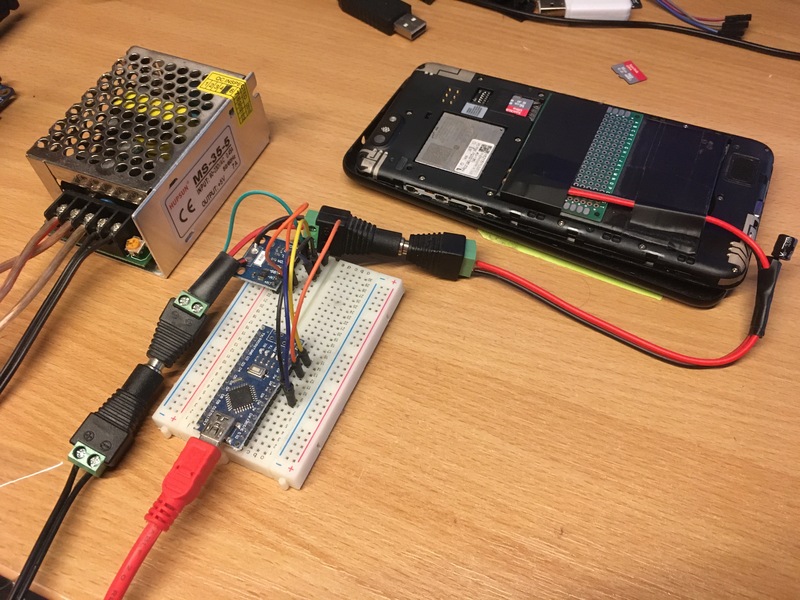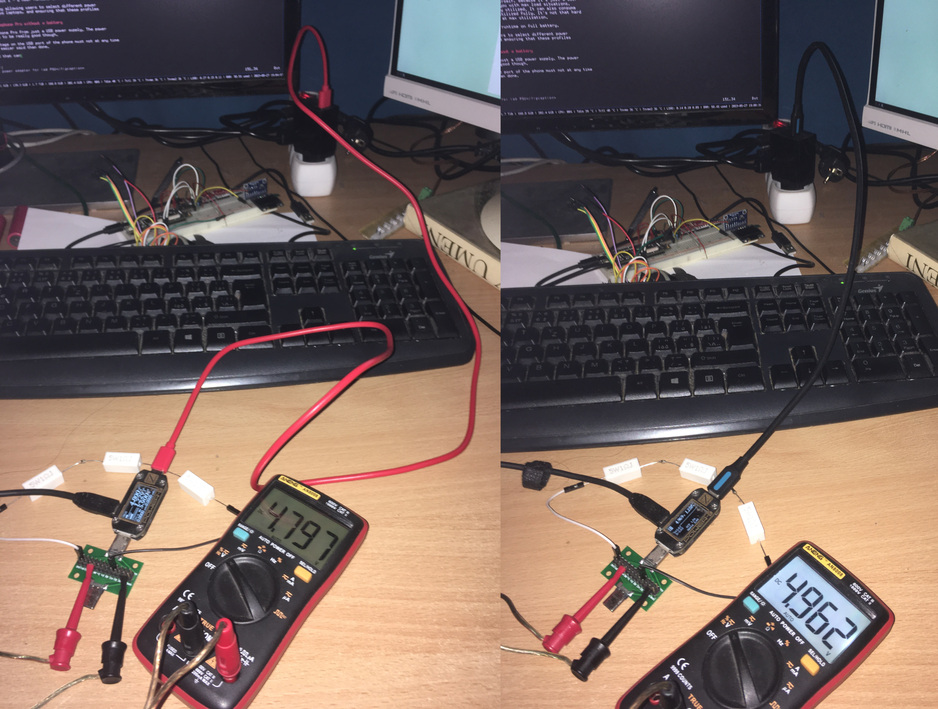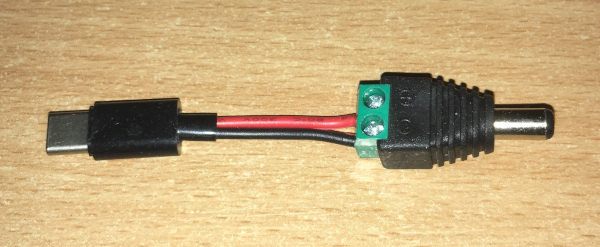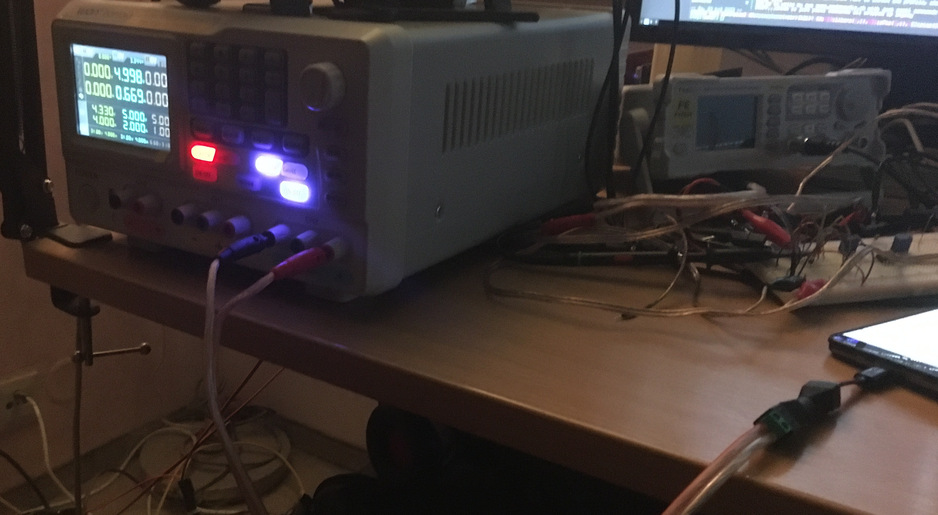2023–05–22:
Pinephone (Pro) power measurements and optimizations
Thanks to support of people who donate money to me, I've been able to add
proper lab PSU to my home's lab equipment, and I am now able to perform
Pinephone power measurements and optimizations in a much more precise and faster
way than before. Thank you for your support! :)
 Pinephone Pro connected to my previous custom made INA226 based
power meter
Pinephone Pro connected to my previous custom made INA226 based
power meter
I've used an old Pinephone battery adapter I made for my previous INA226 based power meter and hooked
Pinephone Pro through it to the new bench PSU.
 Pinephone Pro connected to a laboratory PSU
Pinephone Pro connected to a laboratory PSU
With this setup, I've measured Pinephone and Pinephone Pro power consumption
under different situations with my latest orange-pi-6.3 Linux branch.
Last time I did similar measurements was when Pinephone Pro was initially
announced a year and a half ago. I only did the measurements on the developer
sample of the phone that was using RK3399 SoC, and not the power optimized
RK3399S that the production variant of the phone is using. So an update is
in order.
The following measurments were done on the latest version of Pinephone Pro
which I have access to. It has a batch number MQ2109L2600058 printed on the
sticker on the modem's metal shielding. I'm not aware whether there were any
further HW revisions since then. Probably not.
How long will Pinephone last on a battery can be calculated from power
consumption by dividing battery energy in mWh by the power consumption. Eg.
power consumption is 1000 mW, battery capacity is 11,500 mWh, the phone will
last 11.5 hours.
Please don't use mAh ratings and similar for calculations, because the phone
will draw different current based on how much energy remains in the battery, so
there's no straightforward way to guess how long will the battery last from
that. Ceteris paribus, the power consumption stays roughly constant in the face
of changing battery voltage. Use watts and watt hours, and ignore the
manufacturer's use of mAh. Pinephone battery has ~11.5Wh of energy at full
charge.
Power use in suspend to RAM
Pinephone Pro draws 177 mW in suspend. That's 65 hours of suspend time, if
all you do is have the phone on standby. The phone's modem doesn't add any
significant power consumption on top, assuming you're using the stock firmware,
my modem-power driver, and have adb access to the modem disabled. I haven't
tested any other combination, yet. So I can't tell you about that, but I know
that keeping modem suspended and consuming as little power as possible (~10 mW
as specified in the datasheet) requires careful setup.
(Without adb access disabled, modem adds 50 mW of power consumption, because
having adb enabled prevents it from going to deep sleep.)
Pre-production Pinephone Pro using plain old RK3399 has power consumption in
sleep of 260 mW. Quite a bit higher than RK3399S. It will be interesting to do
these measurements for Pinebook Pro, which also uses RK3399 SoC.
Precision of PMIC's own
measurements
Power management chip (PMIC) in the phone measures current to/from the
battery by measuring a voltage drop on a shunt resistor of 10 mOhm. Looks like
these measurements don't always match with the lab equipment. For example when
/sys/class/power_supply/rk818-battery/current_now says 530 mA my
PSU (and multimeter) measures 450 mA. That's a ~18% difference. This doesn't
scale linearly with current. The percentual difference is different at diferent
power consumption levels. It's more precise with higher current. That suggests
not a scaling problem, but some offset problem.
Looks like ADC has to measure both positive and negative currents, and has
some fixed error offset around 0 mA, that needs calibrating away. When the
current is 0, the ADC will report some small positive or negative current,
unless calibrated. I think this offset simply is 530 - 450 = 80 mA
on my phone. Not insignificant!
The driver does some offset
calibration at various points in the charging cycle, and so the precision of
current measurements will likely depend on eliminating the DC offset of the ADC.
It's good to know this for someone who will take on rewriting the BSP driver
for upstreaming. Replacing the battery erases the store offset measurements from
the PMIC memory.
Power use in idle
Pinephone Pro draws about 1500 mW in idle. By idle I mean the phone has
display turned off, no processes are loading the CPU, and wifi is in power
saving mode, and the user is not interacting with the phone. The phone can stay
for 6.7 hours in this mode on a fully charged battery.
This mode is important to measure, because in this mode, we measure runtime
power management performance of Linux drivers.
Each driver implements two kinds of power management:
In each driver, runtime PM functions, if implemented, should power down
devices that are not used at runtime, when the system is not sleeping as
a whole.
System sleep functions in the driver power down devices when the whole system
is going to sleep.
These two mechanisms are semi-independent, and the driver can implement one
while not the other. Typically system sleep hooks will be implemented, but not
the runtime PM.
Power use in suspend to idle
(s2idle)
Pinephone Pro draws 1250 mW in s2idle. That's 9.2 hours of
suspend time.
All s2idle does is that it tells all drivers to power down the devices in
preparation for system sleep, and then it turns off all CPUs other than the
first one, and makes the first CPU wait for resume interrupt from some wakeup
capable device. It basically goes through all the kernel parts of system sleep
cycle, but doesn't pass the control to platform firmware to bring the system to
deep sleep.
The absolute numbers are not that interesting, but note the difference
between idle and s2idle power consumption! This difference is 250 mW and tells
us how much we can save if we identify drivers that don't implement runtime PM,
and implement support for it in them.
Maximums – max LCD backlight,
max CPU
With max backlight brightness, Pinephone Pro consumes 3.2W in idle and 6.7W
with all CPU cores fully utilized. Yeah, don't run PPP with max backlight and
all cores enabled, unless you want to discharge your battery in less than
2 hours. :)
This is something you have to optimize for yourself, because it's just a
user specific setup. Kernel hacking will not help you with max load situations.
Hardware simply consumes this much, when fully utilized. It can also consume
more than 6.7W, when also eMMC and WiFi are utilized fully. It's not that hard
to get close to 10W, when running everything at max utilization.
You'll get overheating and about 1 – 2 hour runtime on full battery.
Distributions can help here by allowing users to select different power
profiles, just like on Windows laptops, and ensuring that these profiles are
implemented correctly.
USB
power – running Pinephone Pro without a battery (or with an empty
battery)
It's possible to run Pinephone Pro from just a USB power supply.
In fact, Pinephone Pro is quite well suited for running without a battery,
because unlike on the original Pinephone, WiFi and modem will still both work,
when the phone is powered exclusively from the USB port.
The power supply and a USB cable has to be selected with some care,
though.
Technically speaking, voltage on the USB port of the phone must not at any
time drop below 4.3V (and it's better for stability if it doesn't drop below
4.5V). This is easier said than done.
You have to have USB PSU that can handle at least 2A at 5V without voltage
drop and preferably more. You may also need a good quality USB Type-C cable. Any
Type-C to Type-C cable that follows the Type-C specification should do,
but IMMV.
Not all cables are made equal. I've tested some of my USB cables using a ~3
Ohm load which emulates a phone consuming ~6W and Pine64's default red cable
that comes with the phone falls somewhere in the middle. Neither great, nor the
worst. It has about 150 mOhm resistance on VBUS+GND wires. So 2A should not
cause more than 0.3V drop.
If you want something more reliable, short 5A rated Type-C cable will do its
job perfectly. Type-C connector has 4 contacts for VBUS and 4 contacts for
groud, so it's much better than USB-A connectors which can be unreliable with
just one ground and one VBUS contact where contact resistance may vary quite a
bit each time you plug it in. IIRC 5A cables are designed for max 0.25V voltage
drop at 5A.
 Type-C connector has lot's of power connections. It's unlikely all
of the will lose contact at once when you shift things around.
Type-C connector has lot's of power connections. It's unlikely all
of the will lose contact at once when you shift things around.
 Comparing Pine64 USB cable that comes with Pinephone to a short 5A
rated Type-C cable
Comparing Pine64 USB cable that comes with Pinephone to a short 5A
rated Type-C cable
In summary, if you see unreliability booting the phone without a battery,
check your PSU and cables. Remove and insert them a few times to try to reduce
contact resistance, etc. Or just use a full Type-C cable (C connector on
both ends).
Testing battery-less boot
For this test I made a custom Type-C cable for my lab PSU…
 Type-C power adapter for lab PSU
Type-C power adapter for lab PSU
…so I could do measurements and tests that could emulate low/no battery
situations (that currently result in boot loops for users using Tow/U-Boot):
 Powering Pinephone Pro (no battery) from Type-C port via
lab PSU
Powering Pinephone Pro (no battery) from Type-C port via
lab PSU
The basic limitation in this scenario is that the phone starts with a maximum
limit of how much current it can draw from VBUS configured to 450 mA. Even if
you have 3 A power supply, the phone will simply shut down once the 450 mA
limit is crossed.
This limit is not respected by U-Boot/Tow-Boot and both of these bootloaders
proceed with boot even when it's impossible it would succeed. The bootloader
should instead wait for the battery to charge a bit before proceeding, like most
Android and iOS based phones do. Even U-Boot can do things that will cause the
phone to cross the limit, if not careful.
Linux boot is a very power hungry process, where all Linux devices are being
enabled in a short period of time, data is loaded from eMMC at high speed, CPU
cores are busy coordinating everything, and so on. I measured the power needed
for boot of ~9W.
It needs to be explored when exactly is this limit crossed, to understand
what can be done about it, and when exactly it must be raised. I'll explore that
in the next post.
Anyway, with patched levinboot, Pinephone Pro runs fine without the battery
down to about VBUS voltage of 4.3V, according to my measurements. It becomes
unstable at 4.2V or less. Living on the edge is not advised, so let's say
4.5 V minimum on VBUS under all circumstances is a good idea if you want to
run the phone in this manner long term.